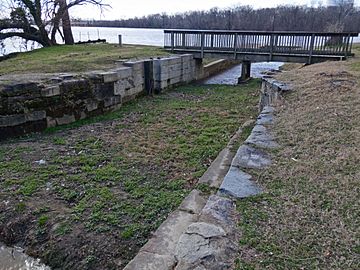Tidewater Lock facts for kids
 |
|
| Waterway | Chesapeake and Ohio Canal |
|---|---|
| Country | USA |
| State | Washington, D.C. |
| Operation | Defunct |
| Length | 54 m |
| Width | 4 m |
| Coordinates | 38°54′00″N 77°03′28″W / 38.8999°N 77.0578°W |
The Tidewater Lock is a special kind of water gate located in Washington, D.C.. It sits near where Rock Creek meets the Potomac River, close to Georgetown.
This lock was built to connect the Chesapeake and Ohio Canal with the Potomac River. It opened in 1831. For many years, it was a very busy place where boats moved between the canal and the river. People sometimes called it Lock 0 or Tide Lock A.
Another lock, called "Tide Lock B," was finished in 1834. It was located further away, at 17th and Constitution Avenue NW.
Today, the Tidewater Lock marks the very beginning (Milestone 0) of the National Park Service's Chesapeake & Ohio Canal trail. It's a great spot to start exploring the history of the canal.
Contents
What is a Canal Lock?
A canal lock is like a water elevator for boats. It helps boats move between different water levels. Imagine a boat needing to go from a high part of a canal to a lower river, or vice versa.
The lock has gates at both ends. When a boat enters, the gates close. Water is then either added to fill the lock or drained to empty it. This changes the water level inside the lock, lifting or lowering the boat.
History of the Tidewater Lock
The Tidewater Lock was a key part of the Chesapeake and Ohio Canal. This canal was very important for moving goods like coal and farm products. It connected the mountains of Western Maryland to Washington, D.C.
The lock allowed canal boats to reach the Potomac River. From there, goods could be loaded onto bigger ships. This made the lock a busy hub for trade and travel.
Building the Lock
Building the Tidewater Lock was a big project. It needed strong stone walls and sturdy wooden gates. Workers had to dig out the land and build the lock chamber.
The lock was designed to handle many boats each day. It helped the canal become a successful way to transport goods for many decades.
The Canal's End
Over time, trains became a faster way to move goods. The canal became less used. Eventually, the Chesapeake and Ohio Canal stopped operating.
The Tidewater Lock also stopped being used for boats. Today, it stands as a historical reminder of a time when canals were vital for transportation.
Images for kids
-
Tidewater lock, with the Watergate complex in the background




